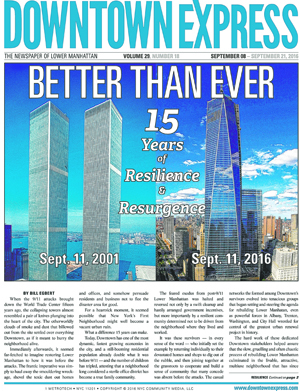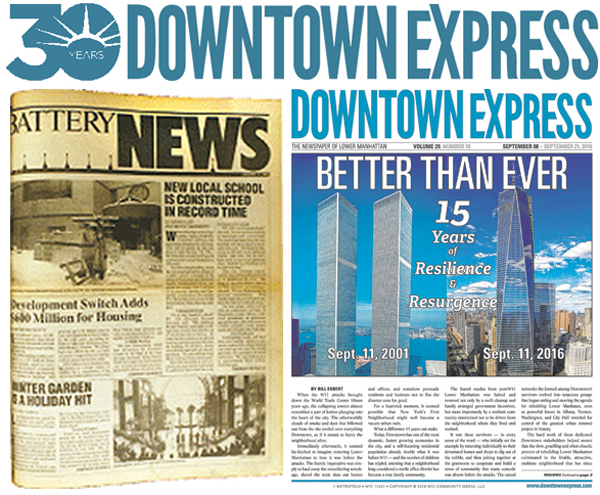
BY BILL EGBERT
Downtown Express turns 30 this year, and like its neighborhood namesake, we have come a long way in the past three decades.
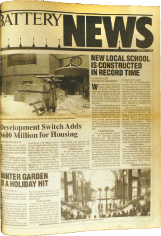 This paper began in the newest part of the oldest neighborhood in the city, created by the Battery Park City Authority to help inform the nascent residential community moving into the still unfinished development. The “Battery News” began publishing as a monthly newspaper in May of 1987 after then-BPCA president and CEO Meyer “Sandy” Frucher tapped Robert Trentlyon of Enlightenment Press to create an independent newspaper.
This paper began in the newest part of the oldest neighborhood in the city, created by the Battery Park City Authority to help inform the nascent residential community moving into the still unfinished development. The “Battery News” began publishing as a monthly newspaper in May of 1987 after then-BPCA president and CEO Meyer “Sandy” Frucher tapped Robert Trentlyon of Enlightenment Press to create an independent newspaper.
In the inaugural issue, Frucher wrote: “It takes more than buildings, parks and trees to make a neighborhood into a community: it takes people. And a local newspaper is the heartbeat of a community.”
Trentlyon later said the authority rarely complained and never interfered with his coverage, but nonetheless, Frucher decided after the first year to sever ties with the paper and have Enlightenment Press make it fully independent. Trentlyson soon made the paper a biweekly and expanded its coverage area to include the newly residentializing Financial District, and eventually the paper’s name changed to reflect that, becoming “Downtown Express” in early 1990.
In those days, Downtown residents were in an exclusive club — whether homesteading on the fresh landfill of Batter Park City, or pioneering the residential-conversion boom in the corporate canyons around Wall Street, the people moving into Lower Manhattan shared a frontier spirit.
Jere Hester, now a professor at CUNY’s Graduate School of Journalism, started out here as an intern reporter back when it was still called the Battery News, before rising to editor and then moving on to become City Editor for the Daily News (and my boss during my own time as a Newser), and he recalled sense of terra incognita in those early days. In our 2007 20th-anniversary edition, he remembered how residents wondered “where am I going to send my kids to school, where are the parks for my kids to play, where am I going to shop, where is a good deli?” In 1990, we reported on how inhospitable Downtown was for new families, with local restaurants even lacking booster chairs for kids.
 A lot has changed since then — but not everything. Now Downtown boasts several parks, from the rolling knolls of Wanger Park, to the ultra-modern, elevated Liberty Park, to the newly renovated Battery. Lower Manhattan has blossomed into one of the city’s premier shopping districts with the opening of the luxe Brookfield Place shopping center, the Oculus-anchored Westfield World Trade Center mall, and the many stores in the Fulton Center transit hub and along the Broadway corridor. And it’s difficult even to list all of the gourmet eateries transforming Downtown into a foodie fantasyland.
A lot has changed since then — but not everything. Now Downtown boasts several parks, from the rolling knolls of Wanger Park, to the ultra-modern, elevated Liberty Park, to the newly renovated Battery. Lower Manhattan has blossomed into one of the city’s premier shopping districts with the opening of the luxe Brookfield Place shopping center, the Oculus-anchored Westfield World Trade Center mall, and the many stores in the Fulton Center transit hub and along the Broadway corridor. And it’s difficult even to list all of the gourmet eateries transforming Downtown into a foodie fantasyland.
But Downtowners are still wondering where they’ll send their kids to school.
That’s mostly due to the success of Lower Manhattan’s residential boom, however. In March 2001, the Downtown Express reported census figures showing that the area’s residential population had grown 43 percent in preceding decade to a whopping 39,536. By the 2010 census, that figure had risen by nearly 65 percent to 60,978. And based on the number of residential units developed since then, Community Board 1 estimates that Downtown’s residential population could hit almost 74,000 this year.
As would be expected in the heart of American capitalism, the law of supply and demand caused housing prices to spiral upwards as the growing population competed for space in the narrow triangle of land at Manhattan’s tip.
In the very first issue of the Battery News, there was an ad for apartments in Liberty Court at 200 Rector Pl., which had just came on the market. A one-bedroom would run you $172,000, a two-bedroom place cost $306,000, and you could land a three-bedroom condo for $825,000. Since then, prices have roughly quadrupled. According to StreetEasy, comparable spaces at Liberty Court today would cost you $790,000, $1,770,000, and $3,225,000, respectively.
Downtown’s rise has not been without its setbacks, of course.
 A startling attack on the World Trade Center by an obscure terrorist group rocked Lower Manhattan and sent many businesses scurrying, leading to speculation about the end of the Downtown boom. It was 1993, and jihadists had just set off a massive bomb in the basement garage of one of the Twin Towers. Three months later, under the headline “Downtown Ghost Town,” we reported on the commercial exodus, but thankfully, reports of the neighborhood’s death were greatly exaggerated.
A startling attack on the World Trade Center by an obscure terrorist group rocked Lower Manhattan and sent many businesses scurrying, leading to speculation about the end of the Downtown boom. It was 1993, and jihadists had just set off a massive bomb in the basement garage of one of the Twin Towers. Three months later, under the headline “Downtown Ghost Town,” we reported on the commercial exodus, but thankfully, reports of the neighborhood’s death were greatly exaggerated.
The early Downtown homesteaders stuck with New York’s first neighborhood, and so did we, reporting on the defiant survivors the 1993 attack, and chronicling the continued development of what has become the city’s most dynamic area. The local reporting of the Downtown Express noted small developments that planted seeds whose full fruits would remain unseen until years later.
In 1989, we reported on “The DeNiro Plan,” an audacious scheme by actor and longtime Tribeca resident Robert DeNiro to transform the Martinson Coffee Exchange Building into a film center with a ground-floor restaurant. In the years since, his Tribeca Grill put the neighborhood on the map as a dining destination. And his Tribeca Film Center became the nexus of the upcoming Tribeca Film Festival, which now rivals Sundance as a venue for top-notch world premieres.
In 1995, we reported on a letter of intent signed by the 45th President of the United States to buy a 70-story office building at 40 Wall Street, which has recently become a magnet for protests.
But of the seeds planted in Lower Manhattan that would eventually grow to great and unexpected flower, none were more consequential than the smouldering ruins at Ground Zero.
The 9/11 terrorist attacks brought down Downtown’s most iconic landmarks, but would give rise to a defiant resurgence the likes of which no one could have foreseen. And the Downtown Express had a front-row seat.
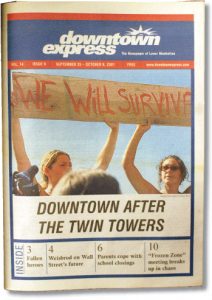 Our first scheduled issue after the attacks, on Sept.25, 2001, bore the headline “Downtown After the Twin Towers,” but the true sentiment was in the picture splashed across the cover: a hand-written sign declaring “We will survive” held aloft.
Our first scheduled issue after the attacks, on Sept.25, 2001, bore the headline “Downtown After the Twin Towers,” but the true sentiment was in the picture splashed across the cover: a hand-written sign declaring “We will survive” held aloft.
The Downtown Express chronicled the neighborhood’s rebuilding and resurgence, and all the growing pains that entailed. From the cacophony of construction, to the revelations of Ground Zero’s poisoned air. From the tragic Deutsche Bank Building fire to the belated opening of the $4-billion Oculus transit hub.
Once solely a center of finance, Downtown has become a major media Mecca. Far from the after-hours ghost town it once was, the Financial District — pardon, Fidi — is growing a vibrant nightlife. And for a neighborhood once synonymous with stodgy corporate types, the Downtown Alliance reported a striking finding in its 2016 residential study — Lower Manhattan now boasts more young professionals than Williamsburg, Brooklyn.
The Downtown Express has reported on this dramatic transformation every step of the way, and even looked at how the neighborhood has become a victim of its own success. Last year we reported how all the new residential developments in the pipeline are expected to dump 19 tons more garbage on Downtown sidewalks every day by 2019.
Over the course of its three-decade existence, the Downtown Express has seen a lot of changes of its own, of course. The paper has changed hands several times, for example, especially in the earlier years.
About a year after Enlightenment Press assumed full control of the paper from the BPCA in 1988, Trentlyon sold the paper to New York Magazine founder Clay Felker, but Enlightenment Press bought the paper back in 1991. Two years later, in late 1993, the Downtown Express ceased publishing because of financial difficulties. But the neighborhood didn’t have to go with out its hometown paper for long — three months later Tom Butson, a former New York Times editor, bought the Downtown Express from Enlightenment Press and fired up the presses again.
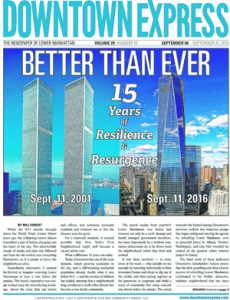 Five years after that, in 1999, John Sutter bought the paper from Butson and remained at the helm for the next 13 years. Sutter, who already owned The Villager newspaper, steered the Downtown Express through Lower Manhattan’s greatest crisis — the 9/11 terrorist attacks and the agonizing aftermath — publishing the biweekly paper on a weekly basis for a time, to give locals the most up-to-date information possible during that chaotic time.
Five years after that, in 1999, John Sutter bought the paper from Butson and remained at the helm for the next 13 years. Sutter, who already owned The Villager newspaper, steered the Downtown Express through Lower Manhattan’s greatest crisis — the 9/11 terrorist attacks and the agonizing aftermath — publishing the biweekly paper on a weekly basis for a time, to give locals the most up-to-date information possible during that chaotic time.
Sutter owned the longer than anyone else, and is still listed on our masthead as Publisher Emeritus, but he eventually sold the Downtown Express — and his other Lower Manhattan papers, The Villager and Chelsea Now — to Jennifer Goodstein in 2012, who is our publisher today.



